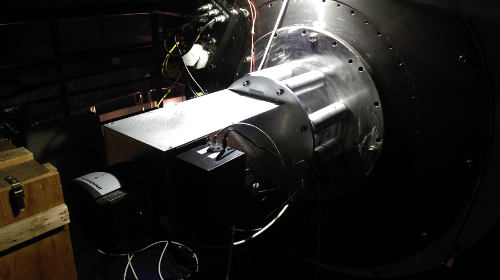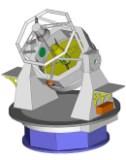
|
русская версия
Speckle polarimeter is a facility instrument of 2.5-m telescope of CO SAI MSU which aims to investigate spatial structure and polarization of astrophysical objects at diffraction limited resolution between 400 and 1100 nm. By design it is a combination of two-beam polarimeter with half--wave plate and speckle interferometer. A fast Electron Multiplying CCD is used as a detector.
|
 |
Description
|
Materials
| Link | [PDF: ??? kb] |
| Title | Differential Speckle Polarimetry of Betelgeuse in 2019--2020: the rise is different from the fall. |
| Authors | Safonov B.S., Dodin A.V., Burlak M.A., Goliguzova M.V., Fedoteva A.A., Zheltoukhov S.G., Lamzin S.A., Strakhov I.A., Voziakova O.V. |
| Date | May 2020 |
| Comment | Preprint, see animation |
| Abstract |
Recently published episodic spectral and high angular resolution observations of Betelgeuse suggest that the deep minimum of 2019-2020 was caused by an enhanced dust abundance in the stellar atmosphere. Detailed monitoring of such events may prove useful for constructing consistent physical models of mass loss by evolved stars. For such observations it is fundamentally important to employ methods resolving an inhomogeneous stellar atmosphere.
We present the differential speckle polarimetric observations of Betelgeuse at 2.5-m telescope of Caucasian Mountain Observatory of SAI MSU covering the period of 2019-2020 minimum...
|
| Link | [PDF: 121 kb] |
| Title | Atmospheric Dispersion Compensator for speckle polarimeter of 2.5 m telescope. |
| Authors | Safonov, B.S. |
| Date | September 2015 |
| Comment | Technical memorandum, 4 pages, in Russian. |
| Abstract |
Here we give computation of basic parameters of atmospheric dispersion compensator which are needed for manufacturing and further use. ADC consists of two non-deviating prisms independtly rotating around optical axis. Thus the angular dispersion of arbitrary value (up to a certain limit) and orientation can be produced. For magnification of 1000 (case of 2.5 m telescope) the compensator will work up to zenith distance of 71 degrees. Each prism consists of F1 glass and fused silica with geometry optimized for the best accordance with atmospheric dispersion between wavelenghts of 400 and 900 nm.
|
| Link | [ADS] |
| Title | On-sky demonstration of optical polaroastrometry |
| Authors | Safonov, B. S. |
| Date | 8 august 2015 |
| Comment | Paper, 12 страниц. Monthly Notices of the Royal Astronomical Society, Volume 451, Issue 3, p.3161-3172 |
| Abstract | A method for measuring the difference between centroids of polarized flux and total flux of an astronomical object – polaroastrometry – is proposed. The deviation of the centroid of flux corresponding to Stokes parameter Q or U from the centroid of total flux multiplied by dimensionless Stokes parameter q or u, respectively, was used as a signal. The efficiency of the method is demonstrated on the basis of observations made in the V band by using an instrument combining features of a two-beam polarimeter with a rotating half-wave plate and a speckle interferometer. The polaroastrometric signal noise is 60-70 μas rms for a total number of accumulated photoelectrons Ne of 10^9 from a 70-cm telescope; this corresponds to a total integration time of 500 s and an object magnitude V = 6 mag. At smaller Ne, the noise increases as ≈ 1.7 arcsec/√Ne, while at larger Ne, it remains the same owing to imperfection of the half-wave plate. For main-sequence stars that are unpolarized and polarized by interstellar dust and the Mira-type variable R Tri the signal was undetectable. For the Mira-type variable chi Cyg the polaroastrometric signal is found to be 310±70 and 300±70 muas for Stokes Q and U, respectively; for o Cet these values are 490±100 and 1160±100 muas. The significant value of the polaroastrometric signal provides evidence of the asymmetry of the polarized flux distribution.
|
| Link | [PDF: 518 kb] |
| Title | Polarimetry at AZT-2 |
| Authors | Safonov B.S. |
| Date | 11 october 2014 |
| Comment | Technical memorandum, 16 pages, in Russian |
| Abstract |
Prototype instrument is a two-beam polarimeter with rotating half-wave plate. It works in V band, polarization fraction and angle are measures. Double difference method is described. On basis of laboratory measurements we show that expected error in determination of dimensionless Stokes parameters is 2e-4 – 3e-4 for objects with polarization of several percents. This level of error was observed indeed for three polarization standards and three non-polarized stars. For other three polarization standards observed values of polarization differ significantly from expected ones, we discuss possible reasons. Instrumental polarization of AZT-2 telescope has been evaluated.
We propose the model adequately describing observed level of measurements uncertainties. Model includes photon noise, readout noise and additional noise of unknown nature which doesn't depend on object brightness. The latter limits accuracy of measurements at 1e-4 - 2e-4 and dominates for objects brighter than V=4. For fainter objects photon noise dominates.
Polarization measurements for three Mirae are given, we note significant change in polarization for two epochs separated by 2 months.
|
| Link | [PDF: 382 kb] |
| Title | Multimode fast camera: prototype design |
| Authors | Safonov, B.S. |
| Date | 1 march 2014 |
| Comment | Technical memorandum, 12 pages, in Russian, v. 1.0 |
| Abstract | Slightly scattered description of design solutions applied in MFC prototype of stage 4. Optical scheme: selection of half-wave plate, selection of beam division element, evaluation of its dispersion effect, selection of optical elements arrangement. Description of optomechanics.
|
| Link | [PDF: 1600 kb] |
| Title | Speckle interferometric observations at AZT-2 telescope using EMCCD sensor. |
| Authors | Safonov B.S. |
| Date | 16 january 2014 |
| Comment | Technical memorandum, 22 pages, in Russian. |
| Abstract |
In this report we present results of first test speckle interferometric observations. We used 70-cm telescope AZT-2 located near SAI building on Vorobyevy Gory in Moscow as a feeding optics. Camera consisted of a EMCCD sensor Andor iXon+897, simple lens reducing focal ratio to F/64 and filter V or interferometric filter with center wavelength 643.4 nm and FWHM 7.9 nm. Angular scale was measured using aperture mask to be 69.98 mas/pix.
From observations of a bright single star we estimated: speckle transfer function, its dependece on wavelength and exposure, FWHM of long-exposure image, image motion spectrum and amplitude, Strehl number of short-exposure images.
Also we observed 20 double stars, which includes both binaries and optical pairs. We measured separation, position angle and magnitude difference. For stars with separation greater than 4" these parameters were estimated from long-exposure images. For closer pairs we performed approximation of averaged power spectrum, i.e. speckle interferometry. Results were compared to ephemeris.
|
| Link | [PDF: 3137 kb] |
| Title | Multimode fast camera for 2.5 m telescope: methods and problems. |
| Authors | Safonov B.S. |
| Date | 16 september 2013 |
| Comment | Presentation for report on seminar "astronomical equipment", in Russian. |
| Abstract | Multimode Fast Camera is an instrument for 2.5 m telescope of SAI which will implement the following passive methods of reconstruction of images disturbed by atmospheric turbulence: speckle interferometry, lucky image, differential speckle polarimetry, differential speckle interferometry. In report we give a short description on methods and estimation of their performance. We present some examples of astronomical problems which can be addressed with these methods: measurement of binary stars parameters, searching for variable stars in crowded fields, cosmic dust characterisation in various astrophysical conditions (exozodiacal clouds, post-ABG stars, comets), investigation of polarization of active galactic nuclei in super-resolution regime. Also we plan to implement SCIDAR – method for measurement of vertical turbulence profile, which differs from others in object of investigation, in case of SCIDAR it is earth atmosphere. We conclude with concept of camera, its preliminary design and status of development. |
| Link | [PDF: 550 kb] |
| Title | Observation of point source emulated in laboratory. |
| Authors | Safonov B.S., Gorbunov I.A., Cheryasov, D.V. |
| Date | 31 July 2013 |
| Comment | Technical report, 14 pages, in Russian, ver. 1.2 |
| Abstract | Here we present results of second phase of investigation of EMCCD sensor iXon+897 (model DU-897E-CS0-#BV, serial X-5947). The sensor is intended for installation in Multimode Fast Camera (MFC). Sensor was tested in conditions similar to observations, we formed image of point source on detector in diffraction limited regime and with simulator of atmospheric turbulence. Some characteristics of turbulence simulator have been estimated: phase structure function and Fried parameter. We also simulaled observations of double source, we measured separation, position angle and flux ratio. As by-product we investigated non-linearity of sensor during registration of image occupying few pixels. |
| Link | [PDF, 818 kb] |
| Title | Differential speckle polarimetry: ExPo method application |
| Authors | Safonov B.S. |
| Date | 24 april 2013 |
| Comment | Technical report, 3 pages, in Russian, ver. 1.0 |
| Abstract | Extreme Polarimeter is
a dual-beam polarimeter which obtains sequence of short-exposure images,
corresponding to orthogonal states of polarisation, swapping them after each
frame by use of half-wave plate. Method includes specialized processing of
data (double difference method). Exchange of beams allows to significantly
reduce influence of instrumental and atmospheric effects. In this report we
considered modification of DSP in the spirit of ExPo. We have shown that
indeed ExPo allows to reduce effect of differential aberrations induced by
optics located downstream relavite to half-wave plate, however this requires
frames period to be less than 10 ms (5 ms is better) in typical conditions
(atmospheric coherence time 3 ms). |
| Link | [ADS,arXiv] |
| Title | Performance analysis of differential speckle polarimetry |
| Authors | Safonov B.S. |
| Date | 1 april 2013 |
| Comment | Refereed paper, 26 pages, Astronomy Letters, Vol. 39, Issue 4, pp. 237-250 |
| Abstract | We consider a method for obtaining information on polarization of astronomical objects radiation at diffraction limited resolution–differential speckle polarimetry. As an observable we propose to use averaged cross spectrum of two short-exposure images corresponding to orthogonal polarizations, normalized by averaged power spectrum of one of images. Information on polarization can be extracted if object under study can be described by model with several parameters. We consider two examples: point-like source whose photocenter position depends on orientation of passing polarization and exozodiacal dust disc around a star. In first case the difference between photocenter positions can be measured with precision of 8 μas for 2.5 m telescope and 1.2 μas for 6-m telescope for object V = 13m. For second example method allows detection of discs around central star of V = 1m with fractional luminosities of 1.8⋅10-5 and 5.6⋅10-6 for 2.5 and 6 m telescope, respectively. |
| Link | [PDF: 1650 kb] |
| Title | Investigation of EMCCD sensor |
| Authors | Safonov B. S. |
| Date | 3 February 2012 |
| Comment | Technical report, 12 pages, in Russian, ver. 1.1 |
| Abstract | In this report we present the results of first phase of investigation of EMCCD sensor iXon+897 (model DU-897E-CS0-#BV, serial X-5947). The sensor is intended for installation in Multimode Fast Camera (MFC).
Report consists of two parts. In first part basic parameters are given: sensitivity (preamp), readout noise, electron multiplication coefficient. Second part is dedicated for more specific characteristics of sensor: dark current, bias stability, flat field inhomogeneity, flat field stability, linearity, vertical clocking effiency, CIC noise. Measurements were made with no illumination and uniform illumination. |
Contact
Boris Safonov: 
|




